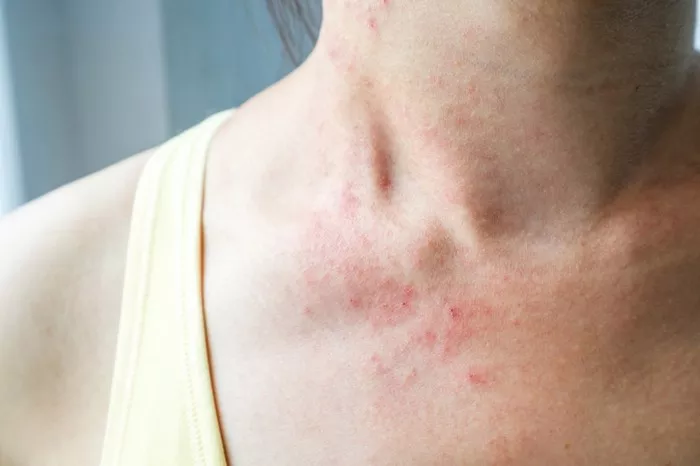Hives, scientifically known as urticaria, are a common skin condition characterized by red, raised, and itchy welts that can appear suddenly and disappear just as quickly. While hives can be triggered by a variety of factors, including medications, insect stings, and environmental factors, one often overlooked cause is food. Understanding the relationship between certain foods and hives is crucial for individuals seeking relief from this bothersome condition.
The Complexity of Food-Induced Hives
Food-induced hives, also known as food-related urticaria, occur when the body’s immune system reacts to specific proteins in food. This reaction triggers the release of histamine and other chemicals, leading to the characteristic symptoms of hives. However, identifying the exact food trigger can be challenging due to several factors:
1. Delayed Onset: Unlike other food allergies that produce immediate reactions, food-induced hives can have a delayed onset, making it difficult to pinpoint the offending food.
2. Variability: Individuals may react differently to the same food, and the severity of the reaction can vary from person to person.
3. Cross-Reactivity: Some foods contain proteins that are structurally similar to those in other foods, leading to cross-reactivity and potential confusion in identifying triggers.
Common Culprits: Foods Known to Trigger Hives
While any food has the potential to trigger hives in sensitive individuals, several common offenders have been identified through research and clinical experience. These include:
1. Shellfish: Shellfish, including shrimp, crab, lobster, and mollusks, are among the most common triggers of food-induced hives. The proteins in shellfish can elicit an immune response in susceptible individuals, leading to hives and other allergic symptoms.
2. Nuts: Peanuts and tree nuts, such as almonds, walnuts, and cashews, are notorious for causing allergic reactions, including hives. Nut allergies tend to be lifelong and are often associated with severe reactions, making them a significant concern for individuals with hives.
3. Eggs: Egg allergy is prevalent in children but can persist into adulthood. Both the egg white and yolk can trigger hives and other allergic symptoms in sensitive individuals.
4. Milk: Cow’s milk allergy is one of the most common food allergies in infants and young children. While many outgrow it by adulthood, some individuals may continue to experience hives and other allergic reactions upon consuming milk and dairy products.
5. Wheat: Wheat allergy is less common than other food allergies but can still cause hives and other allergic symptoms in susceptible individuals. Gluten, a protein found in wheat and other grains, is often blamed for these reactions.
6. Soy: Soy allergy is relatively common, especially in children. Soybeans and soy products can trigger hives and other allergic reactions in sensitive individuals.
SEE ALSO: What Causes Aquagenic Urticaria
Unraveling the Mystery: Strategies for Identifying Food Triggers
Identifying the specific foods that trigger hives can be challenging but is essential for managing the condition effectively. Here are some strategies that can help unravel the mystery:
1. Keep a Food Diary: Keeping a detailed record of everything you eat and any symptoms you experience can help identify patterns and potential food triggers.
2. Elimination Diet: Under the guidance of a healthcare professional, temporarily eliminating common trigger foods from your diet and then gradually reintroducing them one at a time can help pinpoint the culprits.
3. Allergy Testing: Allergy tests, such as skin prick tests and blood tests, can identify specific IgE antibodies to particular foods, providing valuable insight into potential triggers.
4. Consult a Specialist: If you suspect that certain foods are triggering your hives, consider consulting an allergist or immunologist for a comprehensive evaluation and personalized management plan.
Managing Food-Induced Hives: Tips for Prevention and Treatment
Once you’ve identified the foods that trigger your hives, the next step is to manage the condition effectively. Here are some tips for prevention and treatment:
1. Avoid Trigger Foods: The most effective way to prevent food-induced hives is to avoid the foods that trigger them. Read food labels carefully, ask about ingredients when dining out, and be vigilant about cross-contamination.
2. Antihistamines: Over-the-counter antihistamines can help relieve itching and reduce the severity of hives. Non-sedating antihistamines are often preferred during the day, while sedating antihistamines may be more appropriate at night.
3. Epinephrine Autoinjector: If you have a history of severe allergic reactions, including anaphylaxis, your healthcare provider may prescribe an epinephrine autoinjector (e.g., EpiPen) for emergency use.
4. Seek Medical Attention: If you experience severe or persistent hives, difficulty breathing, swelling of the face or throat, or other signs of a severe allergic reaction, seek immediate medical attention.
Conclusion
Food-induced hives can be a source of discomfort and frustration for those affected, but understanding the relationship between certain foods and hives is the first step toward effective management. By identifying trigger foods, implementing preventive measures, and seeking appropriate treatment, individuals with food-induced hives can experience relief and improve their quality of life. Remember, if you suspect that certain foods are triggering your hives, don’t hesitate to seek guidance from a healthcare professional for personalized advice and support.
Related Topics:



























